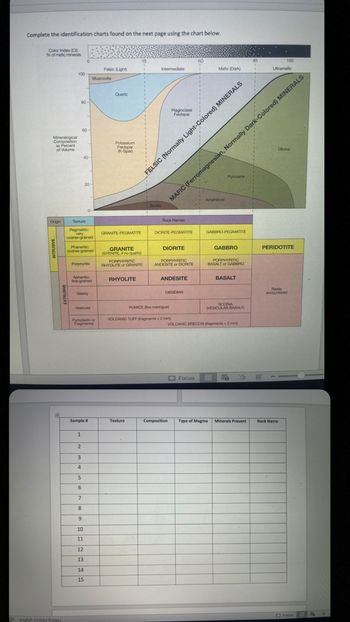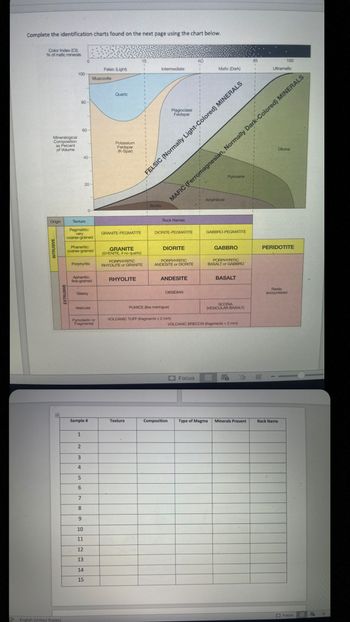identify the rocks while using the map to fill out the chart
Applications and Investigations in Earth Science (9th Edition)
9th Edition
ISBN:9780134746241
Author:Edward J. Tarbuck, Frederick K. Lutgens, Dennis G. Tasa
Publisher:Edward J. Tarbuck, Frederick K. Lutgens, Dennis G. Tasa
Chapter1: The Study Of Minerals
Section: Chapter Questions
Problem 1LR
Related questions
Question
identify the rocks while using the map to fill out the chart

Transcribed Image Text:The image displays a collection of 18 rock samples organized in a tray with each compartment containing a different rock, labeled with a small, numbered sticker. The layout is in three rows, each containing six rocks.
1. **Row 1 (Left to Right)**:
- Sample 1: Gray and white speckled rock.
- Sample 2: Dark, flat rock with a shiny surface.
- Sample 3: Light, coarse-grained rock.
- Sample 4: Dark, jagged rock with a smooth edge.
- Sample 5: Coarse-grained, gray rock with speckles.
- Sample 6: Gray rock with mottled textures.
2. **Row 2 (Left to Right)**:
- Sample 7: Multi-colored rock with white and black areas.
- Sample 8: Light brown, flat rock with a fine texture.
- Sample 9: Dark, coarse-grained rock.
- Sample 10: Marbled dark rock with white inclusions.
- Sample 11: Smooth, dark rock with visible layering.
- Sample 12: Flat, gray rock with minimal patterning.
3. **Row 3 (Left to Right)**:
- Sample 13: Light rock with a rough texture and visible grains.
- Sample 14: Brown rock with a reddish tint and uneven surface.
- Sample 15: Dark, smooth rock with minimal texture variations.
- Sample 16: Light yellowish rock with a coarse texture.
- Sample 17: Black, shiny rock with a reflective surface.
- Sample 18: Dark, flat rock with a matte finish.
These rocks may be used for educational purposes, allowing students to learn about different types of rocks, their textures, and formations.

Transcribed Image Text:The image contains a mineralogical and rock classification chart for educational purposes.
### Diagram Explanation
The upper half of the image displays a ternary diagram used to classify igneous rocks based on mineralogical composition and color index (CI).
- **Color Index (CI)** is represented as a percentage of mafic minerals, increasing from left (Felsic/Light) to right (Ultramafic).
- **Mineralogical Composition** is marked on the vertical axis as a percentage of the total volume of minerals.
The diagram further divides into:
- **Felsic Minerals** (light-colored): Includes Quartz, Muscovite, and Potassium Feldspar (K-Spar).
- **Intermediate Minerals**: Includes Plagioclase Feldspar.
- **Mafic Minerals** (dark-colored): Includes Biotite, Amphibole, Pyroxene, and Olivine.
### Identification Chart
The lower half shows a table with rock names categorized by origin, texture, and composition:
- **Origin**: Divided into Intrusive and Extrusive rocks.
- **Texture**: Ranges from Pegmatitic (very coarse-grained) to Aphanitic (fine-grained), with additional categories for glassy and vesicular textures.
- **Rock Names**:
- **Intrusive**:
- Pegmatitic: Granite-Pegmatite, Diorite-Pegmatite, Gabbro-Pegmatite
- Phaneritic: Granite, Diorite, Gabbro, Peridotite
- Porphyritic: Porphyritic Rhyolite or Granite, Porphyritic Andesite or Diorite, Porphyritic Basalt or Gabbro
- **Extrusive**:
- Aphanitic: Rhyolite, Andesite, Basalt
- Glassy: Obsidian
- Vesicular: Pumice, Scoria
- Pyroclastic: Volcanic Tuff, Volcanic Breccia
### Bottom Section
A table is included for noting rock sample characteristics:
- **Columns**: Sample #, Texture, Composition, Type of Magma, Minerals Present, and Rock Name
- **Rows**: Numbered from 1 to 15 for input.
This chart assists in identifying and classifying various igneous rocks based on their mineral content and textural characteristics.
Expert Solution
Step 1: Introduction
Rocks are aggregates of minerals. Minerals are solid, inorganic substances having a definite chemical composition and chemical structure.
A mineral must be
- A solid
- having definite chemical composition
- Atomic structure
- Crystalline in nature
- Inorganic in nature
Ice is a mineral and water is not as water is a liquid.
All mineral must be crystalline in nature. Obsidia is not crystalline hence it is not a mineral.
“Since you have posted multiple questions, we will provide the solution only to the first five questions as per our Q&A guidelines. Please repost the remaining questions separately.”
Step by step
Solved in 3 steps

Follow-up Questions
Read through expert solutions to related follow-up questions below.
Follow-up Question
identify the rocks while using the map to fill out the chart from #11to #15

Transcribed Image Text:Complete the identification charts found on the next page using the chart below.
Color Index (CI):
% of mafic minerals
Mineralogical
Composition
as Percent
of Volume
Origin
INTRUSIVE
X English (United States)
EXTRUSIVE
100-
80
60-
0
40-
20
Texture
Pegmatitic:
very
coarse-grained
Phaneritic:
coarse-grained
Porphyritic
Aphanitic:
fine-grained
1
Glassy
Vesicular
2
3
4
5
6
7
8
Pyroclastic or
Fragmental
Sample #
Muscovite
9
10
11
12
13
14
15
Felsic (Light)
Quartz
Potassium
Feldspar
(K-Spar)
GRANITE-PEGMATITE
GRANITE
(SYENITE, if no quartz)
PORPHYRITIC
RHYOLITE or GRANITE
RHYOLITE
Texture
Intermediate
Biotite
Plagioclase
Feldspar
Rock Names
FELSIC (Normally Light-Colored) MINERALS
DIORITE-PEGMATITE
DIORITE
PORPHYRITIC
ANDESITE or DIORITE
ANDESITE
OBSIDIAN
PUMICE (like meringue)
VOLCANIC TUFF (fragments s2 mm)
MAFIC (Ferromagnesian, Normally Dark-Colored) MINERALS
Composition
40
Mafic (Dark)
Focus
Amphibole
Pyroxene
GABBRO-PEGMATITE
Type of Magma
GABBRO
PORPHYRITIC
BASALT or GABBRO
VOLCANIC BRECCIA (fragments >2 mm)
BASALT
SCORIA
(VESICULAR BASALT)
85
E
Minerals Present
Ultramafic
100
Olivine
PERIDOTITE
Rarely
encountered
Rock Name
Focus H Po

Transcribed Image Text:1
13
14
15
16
10
17
12
18
Solution
Follow-up Question
identify the rocks while using the map to fill out the chart from #6 to #15

Transcribed Image Text:Title: Identification of Igneous Rocks
### Identifying Igneous Rocks – Instructional Chart
**Instructions:**
Complete the identification charts found on the next page using the chart below.
**Color Index (CI):**
- Represents the percentage of mafic minerals.
- Scale ranges from 0% (Felsic/Light) to 100% (Ultramafic/Dark).
#### Graph Explanation:
The graph illustrates the relationship between mineral composition and the color index of igneous rocks. It is divided into two main categories: Felsic (light-colored minerals) and Mafic (dark-colored minerals), with an intermediate zone between them.
- **Mineralogical Composition as Percent of Volume:**
- Felsic minerals include Quartz, Potassium Feldspar (K-Spar), and Muscovite.
- Intermediate minerals feature Plagioclase Feldspar.
- Mafic minerals encompass Biotite, Amphibole, Pyroxene, and Olivine.
**Rock Types:**
- **Felsic Rocks:** Low on the mafic color index, high silica content.
- **Intermediate Rocks:** Moderate mafic color index, balanced silica content.
- **Mafic Rocks:** High mafic color index, low silica content.
- **Ultramafic Rocks:** Very high mafic color index, very low silica content.
#### Table of Rock Names Based on Origin and Texture:
**Texture Classifications:**
- **Intrusive (Coarse-Grained):**
- **Pegmatitic:** Very coarse-grained rocks like GRANITE-PEGMATITE, DIORITE-PEGMATITE, GABBRO-PEGMATITE
- **Phaneritic:** Coarse-grained textures exemplified by GRANITE, DIORITE, GABBRO, PERIDOTITE
- **Porphyritic:** Contains large crystals embedded in finer-grained matrix, exemplified by PORPHYRITIC RHYOLITE/GRANITE, ANDESITE/DIORITE, BASALT/GABBRO
- **Extrusive (Fine-Grained):**
- **Aphanitic:** Fine-grained texture like RHYOLITE, ANDESITE, BASALT
- **Glassy:** No crystals, represented by OBSIDIAN
- **Vesicular:** Contains vesicles; examples include PUMICE and SCORIA (VESICULAR BASALT)
-

Transcribed Image Text:This is an image of a rock sample collection, displayed in a compartmentalized tray. Each compartment contains a distinct rock specimen, numbered for identification.
### Row 1:
- **Sample 1:** Light-colored rock with a speckled texture.
- **Sample 2:** Dark, possibly metamorphic rock with a smooth surface.
- **Sample 3:** Pale rock with a subtle, grainy appearance.
- **Sample 4:** Dark rock with a rougher texture and some irregular edges.
- **Sample 5 & 6:** Grayish rocks with a pattern that suggests igneous or metamorphic origins.
### Row 2:
- **Sample 7:** Medium gray rock with some darker spots.
- **Sample 8:** Slightly lighter rock, smooth, with a consistent texture.
- **Sample 9:** Darker, coarse-grained rock suggesting a different mineral composition.
- **Sample 10:** Dark black, glossy rock with possible volcanic origin.
- **Sample 11 & 12:** Dark rocks with either a fine-grained texture or smooth finish.
### Row 3:
- **Sample 13:** Speckled rock with a rough texture, possibly sedimentary.
- **Sample 14:** Orange-brown in hue with a complex texture indicating possible mineral inclusions.
- **Sample 15:** Dark rock with a smooth texture and uniform appearance.
- **Sample 16:** Light-toned rock, rough texture with some shine.
- **Sample 17:** Glossy, dark rock, appears dense and smooth.
- **Sample 18:** Extremely dark and smooth rock with flat surfaces.
This collection appears to represent a range of igneous, sedimentary, and metamorphic rocks, useful for educational purposes in geology for understanding different rock types and their properties.
Solution
Recommended textbooks for you

Applications and Investigations in Earth Science …
Earth Science
ISBN:
9780134746241
Author:
Edward J. Tarbuck, Frederick K. Lutgens, Dennis G. Tasa
Publisher:
PEARSON

Exercises for Weather & Climate (9th Edition)
Earth Science
ISBN:
9780134041360
Author:
Greg Carbone
Publisher:
PEARSON

Environmental Science
Earth Science
ISBN:
9781260153125
Author:
William P Cunningham Prof., Mary Ann Cunningham Professor
Publisher:
McGraw-Hill Education

Applications and Investigations in Earth Science …
Earth Science
ISBN:
9780134746241
Author:
Edward J. Tarbuck, Frederick K. Lutgens, Dennis G. Tasa
Publisher:
PEARSON

Exercises for Weather & Climate (9th Edition)
Earth Science
ISBN:
9780134041360
Author:
Greg Carbone
Publisher:
PEARSON

Environmental Science
Earth Science
ISBN:
9781260153125
Author:
William P Cunningham Prof., Mary Ann Cunningham Professor
Publisher:
McGraw-Hill Education

Earth Science (15th Edition)
Earth Science
ISBN:
9780134543536
Author:
Edward J. Tarbuck, Frederick K. Lutgens, Dennis G. Tasa
Publisher:
PEARSON

Environmental Science (MindTap Course List)
Earth Science
ISBN:
9781337569613
Author:
G. Tyler Miller, Scott Spoolman
Publisher:
Cengage Learning

Physical Geology
Earth Science
ISBN:
9781259916823
Author:
Plummer, Charles C., CARLSON, Diane H., Hammersley, Lisa
Publisher:
Mcgraw-hill Education,